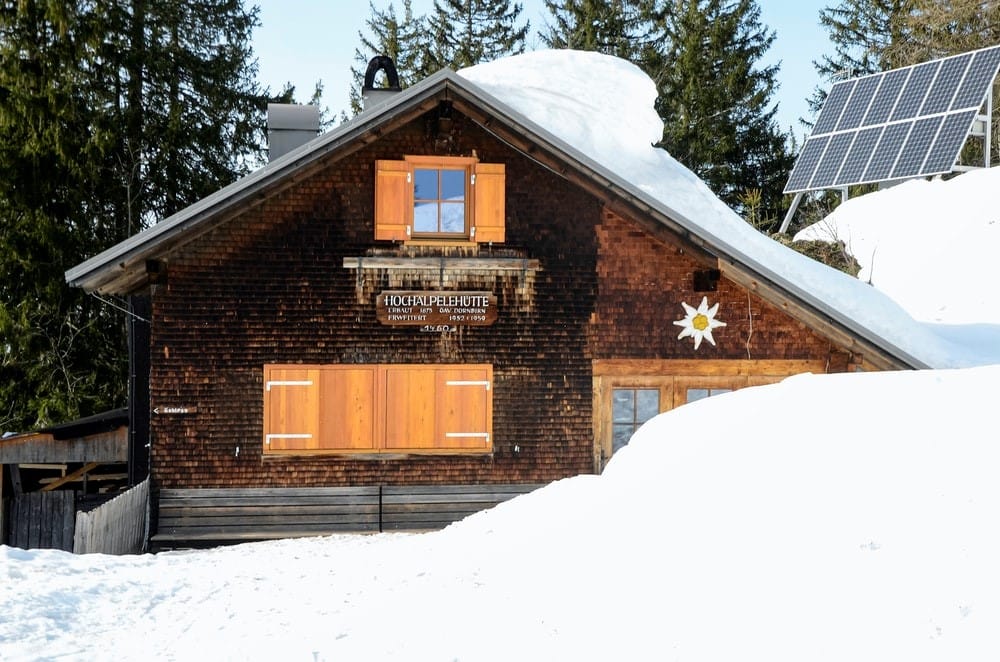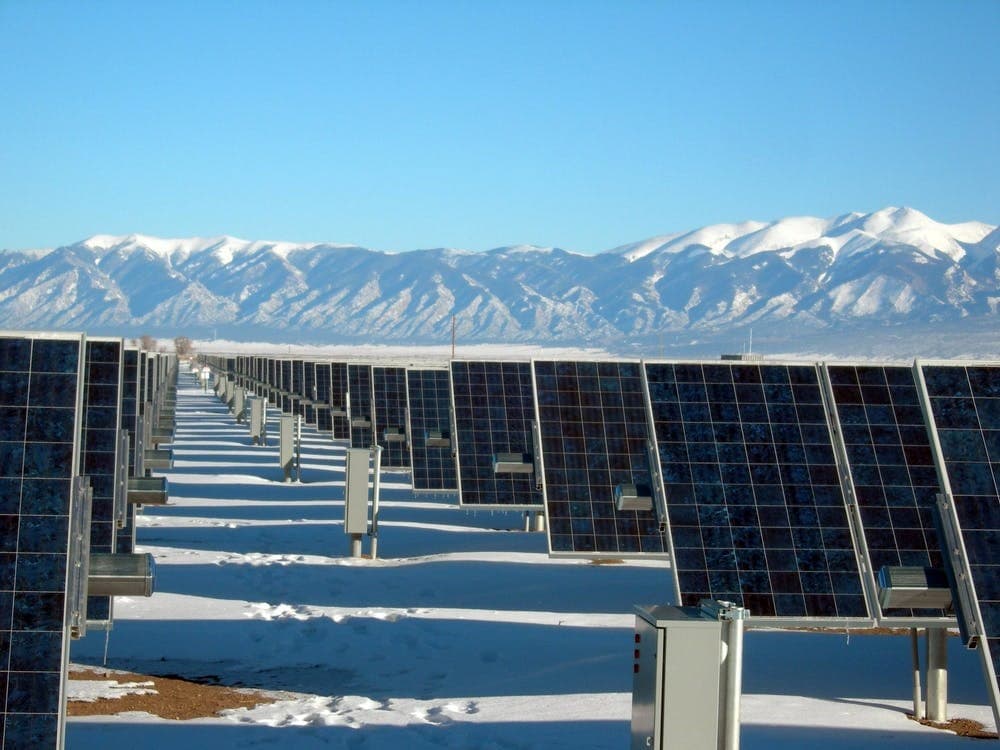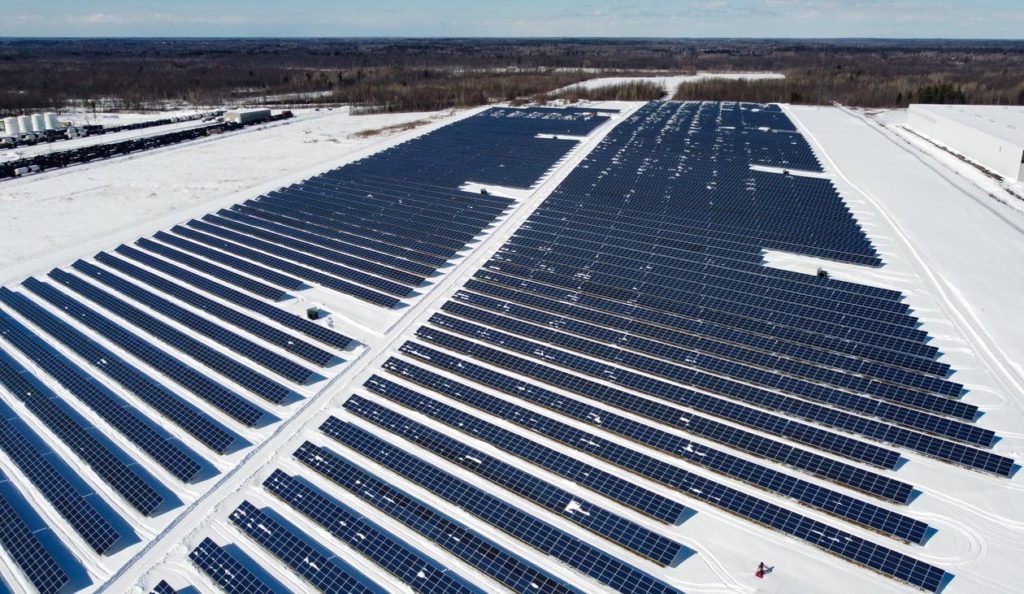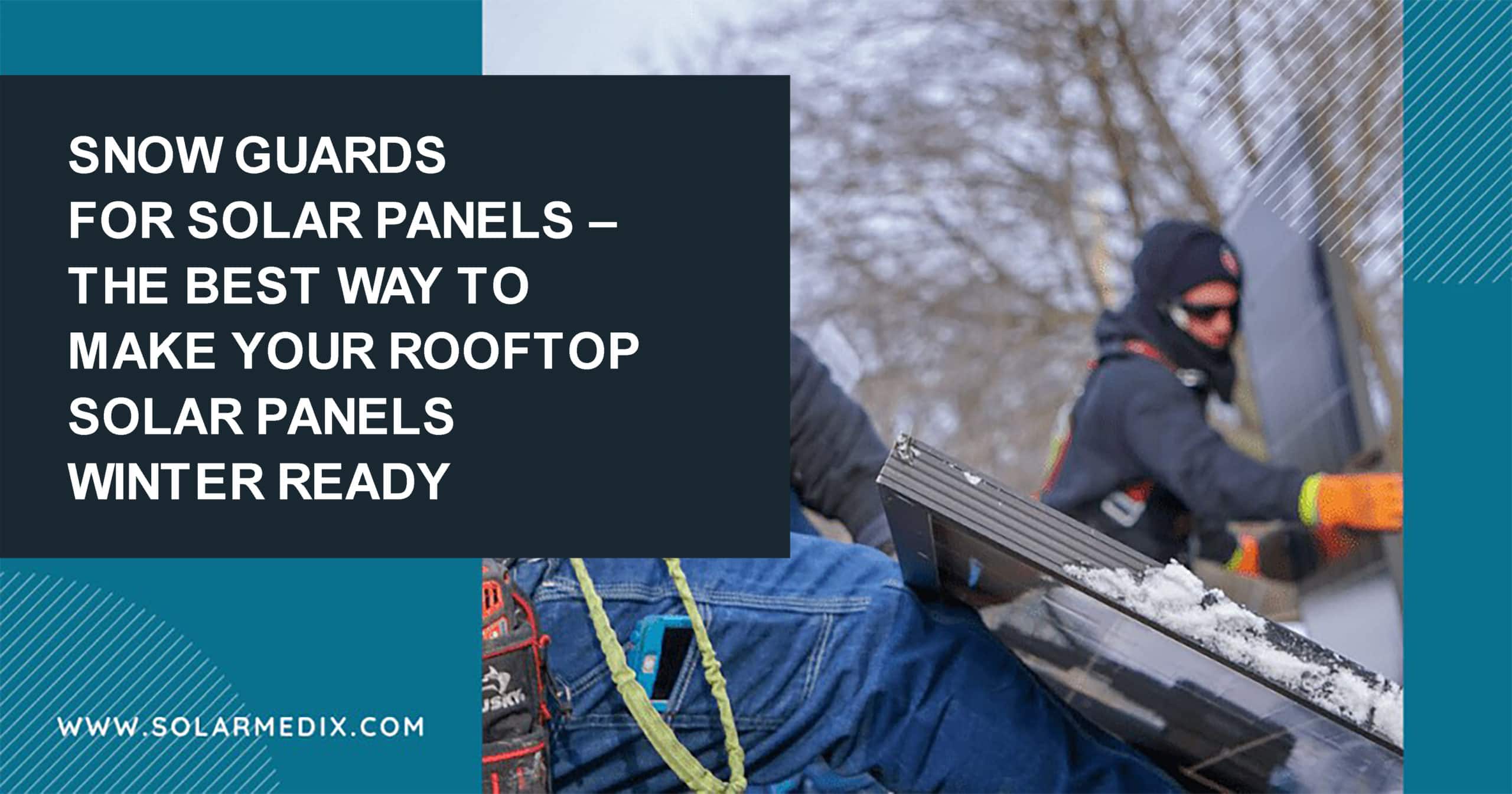
Snow accumulation on rooftop solar panels is a common problem in the colder areas around the United States. Fortunately, snow guards for solar panels have proven to be an effective and simple remedy for the problem. This article will take you through the dangers of snow accumulation on solar panels and how snow guards can help tackle them.
Dangers of Snow Accumulation on Your Rooftop Solar Panels

The majority of homes in the United States have roofs with textured surfaces for enhanced friction. This added friction allows the roof to hold and release gathered snow slowly and safely without harming any objects or people in the surrounding of the home. Due to the shape and orientation of the roof, it sheds snow regularly, in small amounts, without letting too much of it accumulate at any one time.
However, solar panels, on the other hand, aren’t specifically designed to shed snow in the same way a bare roof does. As such, homeowners in the United States with rooftop solar panel systems are presented with a pressing issue involving snow accumulating on their solar panels and sliding off in large, heavy batches.
Following are some of the main issues that you might face if you have a rooftop system and are located in a cold part of the US with a lot of seasonal snow:
Damaged Property
Among the many parts that make up a solar panel, enormous glass panels are at the very top of the list. These tempered glass panels are at the very forefront of a typical solar panel. Therefore, they are the first thing you see and possibly touch when interacting with a solar panel.
The glass panels serve an essential purpose for solar panels that is to protect their fragile internal components from damage by external threats such as harsh weather conditions, rainwater, debris, and other foreign objects. In doing so, the glass panels ensure that the solar panels have a prolonged lifespan and maintain optimal performance.
However, these protective glass panels become a source of threat for your rooftop solar panels, home, and other property. The smooth, texture-less surface of the glass makes for a minimal friction surface, one that is quite slippery. When the snow begins to accumulate on your solar panels, the individual batches of snow become fused together to form a large, heavy sheet that tends to slide off of the glass panel, similar to a dangerous avalanche when snow begins to melt.
The large amounts of heavy snow sliding off from the roof can deal a lot of damage to your property. Firstly, it can block off your front door, thereby cutting off your main entrance. Secondly, if the falling sheet of snow were to land on your car, it could badly damage it. The roof of your car might cave in or the windshield may get cracked under the weight of the snow. Additionally, the sudden and heavy impact could also weaken the suspensions of your vehicle.
Diminished Performance of Your Rooftop Solar Panels
A key factor in determining the performance and efficiency of your rooftop solar system is how clean and obstruction-free the top glass panels of your system are. Even minor shading of the panels can lead to a considerable loss of performance and hence power output. To understand the reason for this, you must first grasp how solar panels function.
Solar panels work by converting the sunlight incident on them into electrical energy. However, to do this, the top glass layer must allow sunlight to pass through it to fall onto the solar PV cells underneath the glass layer responsible for carrying out the aforementioned energy conversion. Keeping this in mind, one can clearly see that the performance and efficiency of solar panels depend on how much sunlight can reach the underlying solar PV cells.
The thick sheet of snow that can gather atop your solar panels during the winter will essentially act as a barricade for any incoming sunlight. This will block off any and all sunlight from reaching the solar PV cells resulting in your rooftop solar panels losing performance and may even cease to function if snow is not removed. This means that your system will be outputting zero amounts of energy, leaving you with no choice but to draw on the gird supplied energy to satisfy your home’s energy needs.
Diminished performance can, in turn, lead to various other drawbacks. For instance, greater reliance on grid-based energy, that too to power your power-hungry devices such as heaters, can lead to inflated energy bills. Also, a lack of savings on your utility bills translates to a poor ROI meaning that the payback period of your solar panel system will be longer.
Damaged Solar Panels
Average rooftop solar panels are designed to hold a weight of 50lbs to 75lbs per square foot; anything more than this can structurally damage your system. While most solar panels are designed sturdy enough to be able to bear the weight of snow, in rare cases, heavy and frequent snowfall during the winters may lead to the accumulation of snow that can weigh more than your panel’s maximum rated value.
The weight of the snow will induce stresses within the structure of your rooftop solar system, which can weaken the frame and mountings of your system. Additionally, a non-uniform load of the snow can also potentially cause microcracks in the panel. The microcracks can, with time, grow into more major fractures that will necessitate the replacement of your rooftop solar panels. Therefore, sustaining such a heavy load for a prolonged time can be detrimental to the health and performance of your system.
Additionally, partial shading of solar panels by snow can cause its own set of problems, such as hot spots. If some portion of your rooftop solar array manages to shed the accumulating snow while the rest is not, this will lead to a section of your system generating power while the rest is inactive due to lack of sunlight.
The inactive cells will not facilitate any flow of current. This means that active cells may have an excessive current flow which can lead to overheating of the cells leading to localized regions of very high temperature that can leave brownish stains on your solar panels called hot spots. This can shorten the life of your solar panel’s internals and lead to faster degradation of their performance.
Snow Guards for Solar Panels – What Are They?
If you’re located in an area that receives heavy and frequent snowfall that can build up several inches of snow on your rooftop solar panels, investing in snow guards for solar panels is a must for you. Installing snow guards during the initial installation of your system will save you a lot of money and time. Snow guards are a simple and effective solution to prevent snow from accumulating on your solar panels or sliding off in a large destructive avalanche.
Installing snow guards is simply an additional step in the process of your solar installation and will not require any special equipment other than the snow guards themselves. If you’re looking to add snow guards to an already installed system, you’ll be glad to know that you can easily do so by contacting a qualified snow guard installing service. But do keep in mind that doing so may require detaching some of the solar panels and reinstalling them.
Snow guards have been designed to grip the snow and ice that gathers on your solar panels. Snow guards hold the sheet of snow back when it begins to slip, preventing it from being released too quickly and falling at a high velocity. In doing so, snow guards mitigate the force with which the sheet of snowfalls hence reducing its potential for causing damage to your property or anyone in the premises.
Additionally, the design and placement of snow guards can also help break down large sheets of ice into smaller portions that weigh less and, therefore, will cause considerably less damage when they fall.
Types of Snow Guards for Solar Panels
Snow guards come in a variety of designs. Generally, snow guards for solar panels have been divided into two categories: snow fence and clamp-on guards.
Consult with a professional snow guard installer to select the type of snow guard that would fit your needs the best.
Clamp-On Snow Guards for Solar Panels
Clamp-on snow guards can be installed in between or at the edge of your rooftop solar panels. These solar guards hook into the snow releasing small amounts of it slowly, thereby preventing a devastating avalanche.
Following are some excellent clamp-on snow guard options you should look into:
Alpine SnowGuards
Alpine SnowGuards are secured to the solar panel frame using a screw-on clamp that holds the snow guard firmly in its place. Alpine SnowGuards offers a wide range of snow guard designs and have an option that is perfect for each roof type. A bonus point of these snow guards is that they are manufactured out of recycled materials.
ColorGard®
ColorGard® by S-5! Clamps onto solar panels using round-point screws eliminate the necessity for penetrating the solar panel frame and, in doing so, does not damage the finish of the panels. The guards can be custom designed to match the finish and color of your roof to achieve a simple and elegant look.
SnowBreaker
SnoBlox’s SnowBreaker is a one-of-a-kind snow guard engineered to that break apart large sheets of ice and snow into smaller portions before allowing it to slide off the solar panel. These forward-facing snow guards can be fitted mechanically using snow-safe adhesive or clamps. Each SnowBreaker snow guard can hold up to 3,456 pounds if installed with a clamp, and when installed with adhesive, it can hold up to 1,379 pounds.
Snow Fence Snow Guards
To minimize the impact on the solar panel itself, snow fence solar guards have been engineered to be mounted directly onto the roof rather than from the solar panels. The on-roof installation makes these snow guards an easier option for folk that are looking to get snow guards for solar panels that are already installed. These can also be readily installed on roofs that have not yet been ornamented with solar panels.
The Snow Fence
The Snow Fence snow guard by Rocky Mountain Snow Guards is one of the most popular options on the market. This snow barrier is fitted at the eave of your roof to catch the snow as it rolls down the solar panels. The Snow Fence requires a minimum of 18-24 inches between the lowest solar panel and the roof eave since it needs a snow gathering area.
Can’t We Just Melt the Snow?

There are systems available on the market that use small amounts of energy to heat up solar panels in order to melt off the snow. While this technology appears to be an effective and simple solution, it, however, poses a potential problem for rooftop solar systems.
The issue with this technique is that the runoff water from the melting snow could drip from the solar panels and refreeze on the roof. Other technologies, such as electric heat-lines or heat-tape, have been suggested as possible alternatives; however, the issue of melting and refreezing remains.
This refreezing of the runoff water can cause problems such as ice damming. This entails that the newly formed ices prevent any water on your roof from draining into the gutters. This standing water can degrade the roofing materials and seep into your home through the roof shingles leading to water damage.
Additionally, this technique would subject you to additional expenses for procuring, installing, and maintaining these devices, which may not justify investing in them when there are more economical and less risk-free alternatives such as installing snow guards for solar panels. Given this, snow-melting devices may be viable only in large-scale ground-based solar projects or isolated applications where solar power is crucial, and no one is available to brush the snow off.
Frequently Asked Questions (FAQs)
Do Solar Panels Create Ice Dams?
While solar panels can accumulate snow and ice, they do so atop their own surfaces and not on the roof. With that said, solar panels do not create ice dams.
How Much Snow Can Solar Panels Hold?
Most solar panels have a snow load rating of 5000 Pa or above. This translates to roughly 2-4 feet of snow.
Can Solar Panels Melt Snow?
Solar panels work by absorbing the sun’s radiation and, therefore, warm-up during operation. Given that your solar panels are not entirely covered by snow, the region exposed to the sun will spread heat throughout the solar panels, thereby melting the snow.
How Much Do Snow Guards for Solar Panels Cost?
The cost of snow guards depends on the style of guard you choose and the size of your roof. On average, snow guards for solar panels can cost you from $1.50 to $3.00 per foot, excluding installation costs.
Can Snow Guards Be Installed for Existing Solar Panels?
Yes! Snow guards can be installed on newly installed solar systems as well as on existing systems.
Conclusion
If you live in an area where heavy snowfall is a common occurrence and can lead to several feet or inches of snow accumulation on your rooftop solar panels in a short period of time, you should definitely invest in snow guards for solar panels. On the other hand, if a little light snow dusting is all you get during winter, snow guards shouldn’t be a necessity.
The team at Solar Medix are ready to answer your questions and give you a no-obligation price quote. Feel free to call us at 732-785-4814 or book a consultation online. And we’ll get in touch within 24 hours.













